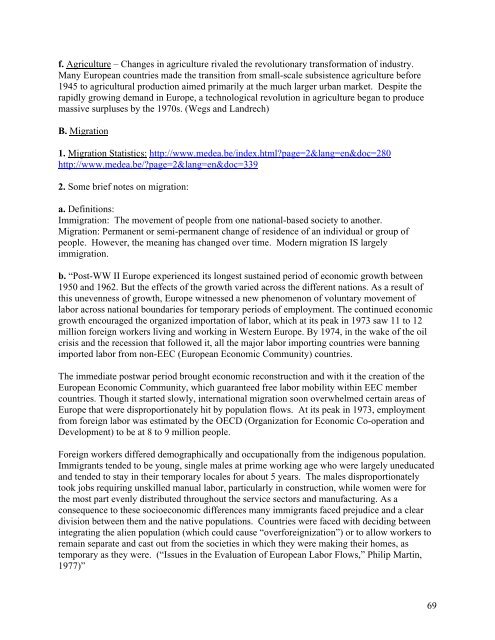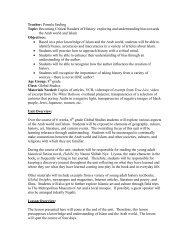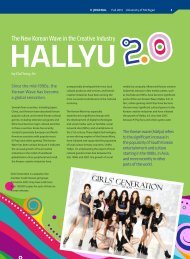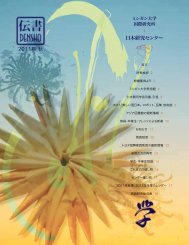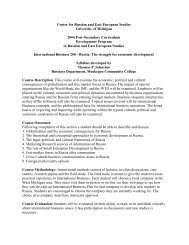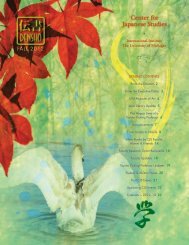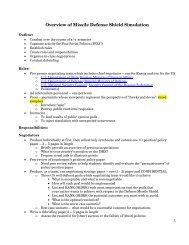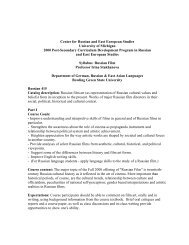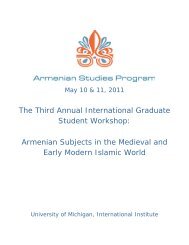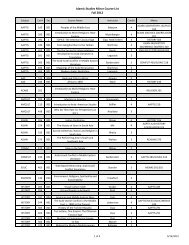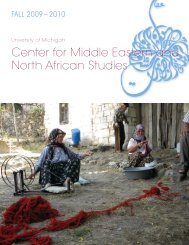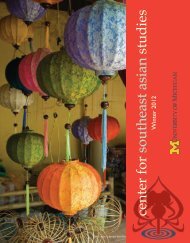Muslims in Europe: - International Institute - University of Michigan
Muslims in Europe: - International Institute - University of Michigan
Muslims in Europe: - International Institute - University of Michigan
Create successful ePaper yourself
Turn your PDF publications into a flip-book with our unique Google optimized e-Paper software.
f. Agriculture – Changes <strong>in</strong> agriculture rivaled the revolutionary transformation <strong>of</strong> <strong>in</strong>dustry.<br />
Many <strong>Europe</strong>an countries made the transition from small-scale subsistence agriculture before<br />
1945 to agricultural production aimed primarily at the much larger urban market. Despite the<br />
rapidly grow<strong>in</strong>g demand <strong>in</strong> <strong>Europe</strong>, a technological revolution <strong>in</strong> agriculture began to produce<br />
massive surpluses by the 1970s. (Wegs and Landrech)<br />
B. Migration<br />
1. Migration Statistics: http://www.medea.be/<strong>in</strong>dex.html?page=2&lang=en&doc=280<br />
http://www.medea.be/?page=2&lang=en&doc=339<br />
2. Some brief notes on migration:<br />
a. Def<strong>in</strong>itions:<br />
Immigration: The movement <strong>of</strong> people from one national-based society to another.<br />
Migration: Permanent or semi-permanent change <strong>of</strong> residence <strong>of</strong> an <strong>in</strong>dividual or group <strong>of</strong><br />
people. However, the mean<strong>in</strong>g has changed over time. Modern migration IS largely<br />
immigration.<br />
b. “Post-WW II <strong>Europe</strong> experienced its longest susta<strong>in</strong>ed period <strong>of</strong> economic growth between<br />
1950 and 1962. But the effects <strong>of</strong> the growth varied across the different nations. As a result <strong>of</strong><br />
this unevenness <strong>of</strong> growth, <strong>Europe</strong> witnessed a new phenomenon <strong>of</strong> voluntary movement <strong>of</strong><br />
labor across national boundaries for temporary periods <strong>of</strong> employment. The cont<strong>in</strong>ued economic<br />
growth encouraged the organized importation <strong>of</strong> labor, which at its peak <strong>in</strong> 1973 saw 11 to 12<br />
million foreign workers liv<strong>in</strong>g and work<strong>in</strong>g <strong>in</strong> Western <strong>Europe</strong>. By 1974, <strong>in</strong> the wake <strong>of</strong> the oil<br />
crisis and the recession that followed it, all the major labor import<strong>in</strong>g countries were bann<strong>in</strong>g<br />
imported labor from non-EEC (<strong>Europe</strong>an Economic Community) countries.<br />
The immediate postwar period brought economic reconstruction and with it the creation <strong>of</strong> the<br />
<strong>Europe</strong>an Economic Community, which guaranteed free labor mobility with<strong>in</strong> EEC member<br />
countries. Though it started slowly, <strong>in</strong>ternational migration soon overwhelmed certa<strong>in</strong> areas <strong>of</strong><br />
<strong>Europe</strong> that were disproportionately hit by population flows. At its peak <strong>in</strong> 1973, employment<br />
from foreign labor was estimated by the OECD (Organization for Economic Co-operation and<br />
Development) to be at 8 to 9 million people.<br />
Foreign workers differed demographically and occupationally from the <strong>in</strong>digenous population.<br />
Immigrants tended to be young, s<strong>in</strong>gle males at prime work<strong>in</strong>g age who were largely uneducated<br />
and tended to stay <strong>in</strong> their temporary locales for about 5 years. The males disproportionately<br />
took jobs requir<strong>in</strong>g unskilled manual labor, particularly <strong>in</strong> construction, while women were for<br />
the most part evenly distributed throughout the service sectors and manufactur<strong>in</strong>g. As a<br />
consequence to these socioeconomic differences many immigrants faced prejudice and a clear<br />
division between them and the native populations. Countries were faced with decid<strong>in</strong>g between<br />
<strong>in</strong>tegrat<strong>in</strong>g the alien population (which could cause “overforeignization”) or to allow workers to<br />
rema<strong>in</strong> separate and cast out from the societies <strong>in</strong> which they were mak<strong>in</strong>g their homes, as<br />
temporary as they were. (“Issues <strong>in</strong> the Evaluation <strong>of</strong> <strong>Europe</strong>an Labor Flows,” Philip Mart<strong>in</strong>,<br />
1977)”<br />
69


